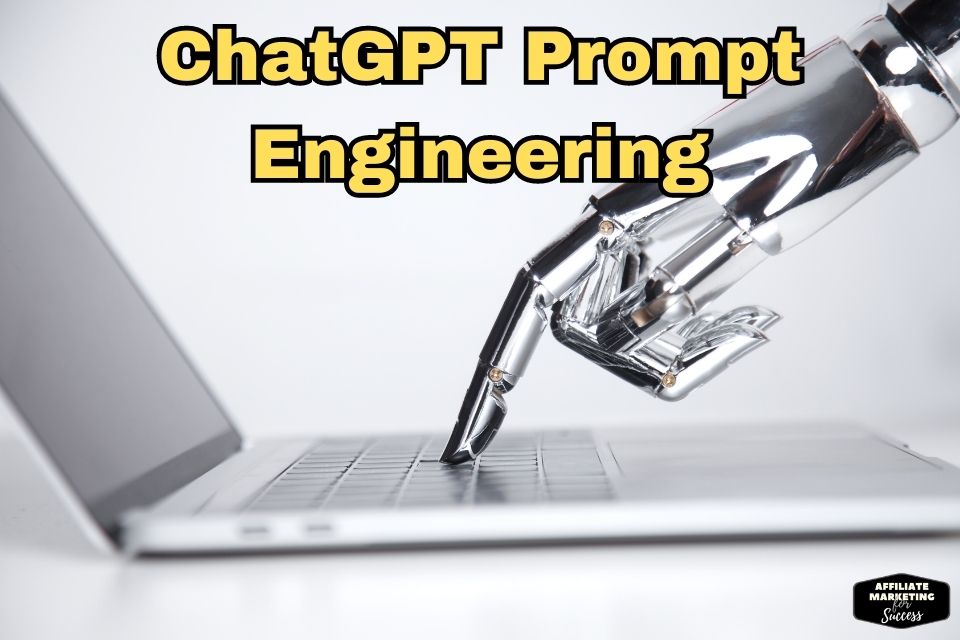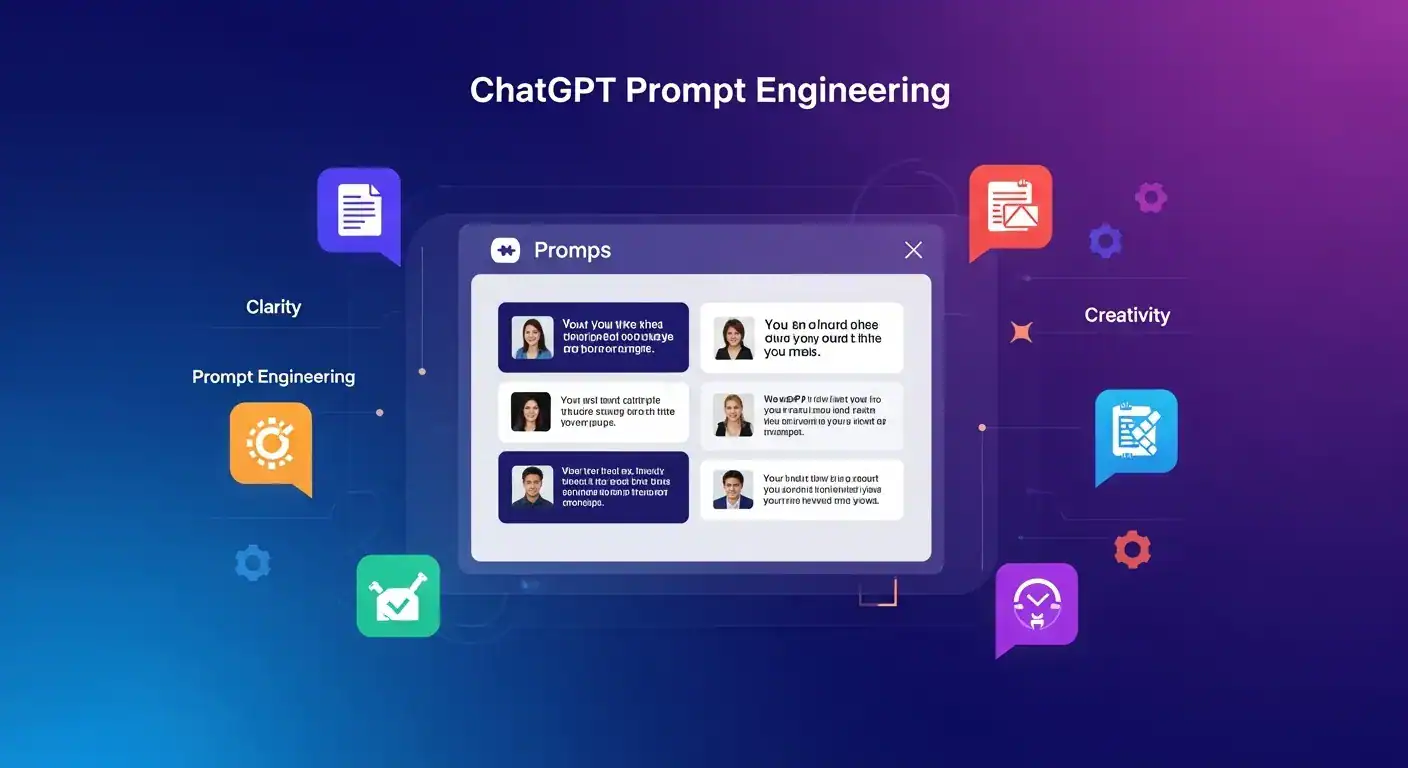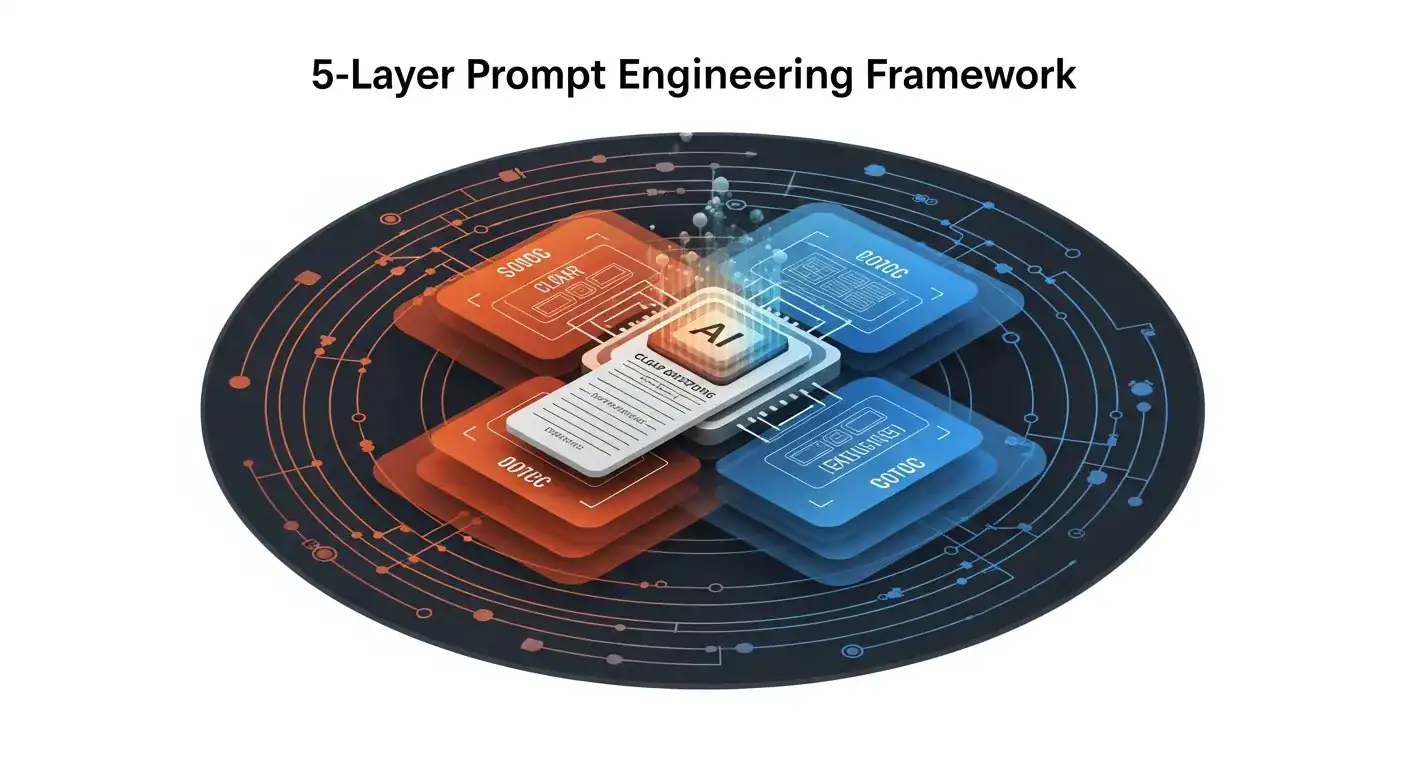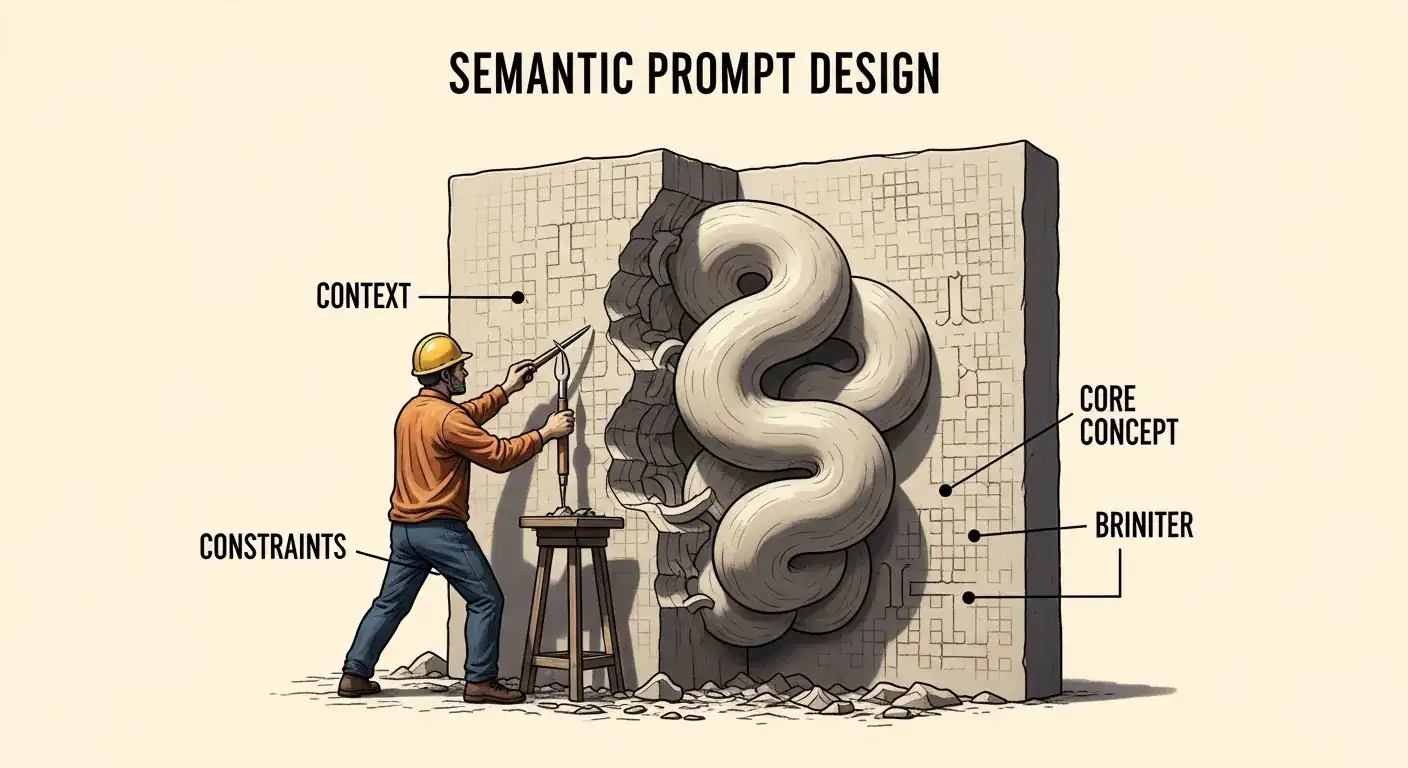The Complete Beginner’s Guide to ChatGPT Prompt Engineering (No Coding Required)
Key Takeaways:
- Importance: ChatGPT prompt engineering is crucial for optimizing interactions and ensuring accurate outputs. Learn more about its significance in our What is AI Prompt Engineering? guide.
- Master the 5-Layer Framework, not templates – Professional prompt engineers use Context Architecture → Semantic Design → Instruction Engineering → Output Optimization → Iteration Protocol, not memorized templates
- Chain of Thought is a complete reasoning system – It’s not just “think step by step” – it involves cognitive path mapping, progressive complexity scaling, and error cascade prevention
- Build prompt systems, not individual prompts – Companies hire for systematic thinking and scalable solutions that automate workflows, not one-off clever prompts
- Learning Resources: Enroll in a ChatGPT Course or use online resources to build in-demand skills. Explore course content through Jupyter Notebook and address frequently asked questions.
- Best Practices: Regularly create prompts, understand LLMs’ limitations, maintain ethical standards, and consider Ethical Implications of AI.
- Privacy Policy: Always consider privacy policy implications when using AI tools.
What is Prompt Engineering? (And Why Should You Care?)
The $175,000 Question Nobody’s Asking
- Design prompt systems that automate entire workflows
- Create consistent brand voices across AI-generated content
- Build prompt architectures that scale across teams
- Optimize prompts for specific business outcomes
What is ChatGPT Prompt Engineering?
Prompt engineering for chatgpt is essential for effective interaction with large language model like gpt can produce diverse outputs based on the input prompts.s. is the art and science of designing effective inputs (prompts) for language models like ChatGPT to achieve desired outputs.
It’s not just about asking questions, but about understanding how these language models think and using that knowledge to get better results. This means less trial and error, more relevant responses and ultimately, more success.
- Language Models: ChatGPT is one of many language models, and their accuracy depends heavily on the quality of prompts. Learn more about How ChatGPT Works.
- Effective Prompts: Well-crafted prompts are the key to unlocking powerful applications from AI.
- Relevant Responses: When you learn prompt engineering, you’re teaching your AI to give you the information you need.
- Prompt Engineers: This emerging field highlights the importance of this skill, showing its relevance in our evolving digital economy. Discover Prompt Engineering Jobs.
- Generative AI: Prompt engineering is fundamental to getting the most out of generative AI tools.
Why is Prompt Engineering Important?
Without effective prompts, you’re leaving your AI’s capabilities untapped. Think of it like giving a chef ingredients without a recipe – the outcome will be unpredictable. Prompt engineering is the recipe. It allows you to guide AI, refine its responses, and achieve results that are accurate and useful, as the information it provides directly affects your business decisions.
- Improved Accuracy: The right prompts lead to more accurate responses and human-like text.
- Time Savings: You’ll spend less time refining outputs if you’re better at crafting the initial prompt.
- Increased Efficiency: Prompt engineering helps you get the most out of AI for a variety of tasks.
- Better Content: Craft compelling content for your blog using effective prompts, driving traffic and conversions.
Learn how to Create Evergreen Content.
Why Learn ChatGPT Prompt Engineering?
Poor prompts = wasted time, especially when using advanced llms like gpt. Great prompts = powerful applications and the exact results you need. Whether you’re generating content, brainstorming ideas, or building a custom chatbot, mastering prompts is your superpower.
The Core: Writing Super Effective Prompts
| Element | How to Make it Effective | Example |
| Be Specific | State exactly what you want. Avoid ambiguity. | Instead of: “Write about AI.” Try: “Write a blog post explaining how Generative AI is changing marketing.” |
| Define the Task | Use action verbs. Tell ChatGPT what to do. | “Summarize,” “Translate,” “Analyze,” “Generate,” “Create.” For example: “Translate this sentence into Spanish: ‘Hello, world.'” |
| Set the Format | Specify the output type (list, paragraph, table, code). | “Generate a numbered list of 5 marketing strategies.” |
| Tone/Style | Indicate the desired voice (formal, informal, etc.). | “Write a humorous tweet about the struggles of learning Prompt Engineering.” |
| Provide Context to enhance the effectiveness of your prompt engineering for chatgpt. | Give background info. Help ChatGPT understand the goal. | “I’m a blogger writing for beginners. Explain what Prompt Engineers do.” |
Key Takeaway: Clear instructions are non-negotiable for effective prompts.
The Hidden Truth About Prompt Engineering Careers
- AI Implementation Specialists
- Conversational AI Designers
- AI Product Managers
- Automation Consultants
- AI Content Strategists
The 5-Layer Prompt Engineering Framework (What Experts Actually Use)
Layer 1: Context Architecture
Before writing any prompt, professionals map out:
- The AI model’s knowledge boundaries
- Required context windows
- Information hierarchy
- Output constraints
Layer 2: Semantic Design
This involves understanding how to:
- Structure information for optimal AI comprehension
- Use semantic markers effectively
- Build conceptual bridges between ideas
- Create clear logical flows
Layer 3: Instruction Engineering
Professional prompts include:
- Explicit success criteria
- Fallback instructions
- Error handling protocols
- Quality checkpoints
Layer 4: Output Optimization
This covers:
- Format specifications
- Style guidelines
- Consistency rules
- Validation criteria
Layer 5: Iteration Protocol
The most overlooked aspect:
- Systematic testing methodologies
- Performance metrics
- Refinement strategies
- Version control systems
Basic Prompting Techniques: Starting Strong
Before you can run, you need to walk. Here are some basic yet crucial techniques:
Be Specific
Vague requests yield vague results. Instead of a basic prompt like “write a blog post,” try: “Write a 500-word blog post about the benefits of affiliate marketing for beginners, focusing on the passive income potential. Use a conversational tone.” This way, you can get more relevant responses.
Use Clear Instructions
Tell ChatGPT exactly what you want. Do you need a list, a paragraph, or a table? Do you want it to act like a specific professional, such as a business analyst (Research) using llms? The more explicit you are, the better the model outputs will be.
Provide Context
Always provide enough background information so that the language model understands the situation. If it’s a blog post, mention who your target audience is. If it’s a piece of code, explain what the code should do. Remember to add additional context whenever needed.
Example of an Unclear Prompt
“Write about marketing.”
Example of a Clear Prompt
“Act as an expert digital marketer. Write a 300-word article about email marketing benefits for small businesses. Include practical examples that a beginner can use and avoid jargon.”
Intermediate Prompt Engineering: Leveling Up
Once you’ve got the basics down, you can delve into these intermediate techniques:
Zero-Shot Prompting
This is when you give the AI a task without any examples. It relies on the model’s existing knowledge. It’s a good starting point.
Example:
“Summarize the main points of the book ‘Sapiens: A Brief History of Humankind’.”
Few-Shot Prompting
This is where you provide a few examples to guide the AI. It helps the model understand the desired pattern, resulting in better output.
Example:
“Here are some examples of writing styles. Use this style to write a paragraph about AI:
Example 1: Short, punchy sentences, very direct.
Example 2: Detailed descriptions, using metaphors.
Write an article about ChatGPT, using the detailed description, metaphor style.”
Chain-of-Thought Prompting
Break down complex tasks into smaller steps for the AI to follow. This technique is great for problem-solving.
Example:
“First, outline the steps needed to create a blog post. Second, use that outline to write an introduction to a blog post about why affiliate marketing is a great option for making money. Third, use that introduction to expand the blog post into a 500-word article”
Advanced Prompt Engineering: The Secret Sauce
Here’s where we unlock the truly powerful techniques:
Role-Playing
Tell the AI to act as a specific expert. This will alter its tone and approach. Try using role prompts such as “act as a marketing copywriter” or “act as a seasoned digital entrepreneur.” This can be a game-changer, allowing you to unlock better responses and content generation capabilities.
Persona Prompts
- Example: “You are a witty, sarcastic blogger who writes about technology.”
Format Requirements
Provide your required output format such as numbered lists, bullet points, code blocks, and JSON objects. Remember to specify format requirements so your results are exactly what you need.
Example:
“Write three bullet points summarizing the benefits of affiliate marketing, followed by a table comparing different affiliate programs.”
Iterative Prompting
Don’t expect perfection on the first try. Refine your prompts based on the responses you get. If the output isn’t perfect, go back and change your prompt engineering skills to refine the results. initial prompt. Prompt engineering is an iterative process, so use this to your advantage.
Prompt Engineering Examples You Can Use Now
| Prompt Type | Example Prompt | Benefit |
| Blog Post Outline | “Create a blog post outline about ChatGPT prompts for beginners, including sections on basic and advanced techniques.” | Provides a structured starting point for content creation. |
| Social Media Post | “Write a short, engaging LinkedIn post about the importance of prompt engineering for businesses using language models.” | Generates ready-to-use content for social media. |
| Email Subject Line | “Generate 5 catchy email subject lines about learning effective prompts for ChatGPT.” | Helps increase email open rates. |
| Product Description | “Write a concise and persuasive product description for a course teaching Prompt Engineering for Developers.” | Creates compelling marketing copy. |
| Code Explanation | “Explain this Python code snippet as if I were a beginner: [Paste Code].” | Makes complex code understandable. |
Action Step: Copy and paste these examples, replacing the bracketed information with your own needs!
Chain of Thought Prompting: The $50K Skill Nobody Teaches Correctly
1. Cognitive Path Mapping
Before asking the AI to think step-by-step, you need to:
- Identify the optimal reasoning path
- Anticipate potential logical branches
- Build in correction mechanisms
- Create verification checkpoints
2. Progressive Complexity Scaling
Start with simple reasoning chains and gradually increase complexity:
Level 1: Single-step inference
Level 2: Multi-step with dependencies
Level 3: Branching logic paths
Level 4: Recursive reasoning loops
Level 5: Meta-cognitive analysis
3. Error Cascade Prevention
Professional chain of thought prompts include:
- Logic validation at each step
- Assumption checking protocols
- Contradiction detection
- Confidence scoring
Zero-Shot vs. Few-Shot Prompting: The Million Dollar Distinction
The Strategic Framework
Zero-Shot Prompting Excellence:
- Requires deep understanding of model capabilities
- Demands precise semantic engineering
- Focuses on universal principles
- Scales infinitely without examples
Few-Shot Prompting Mastery:
- Involves strategic example selection
- Requires pattern abstraction skills
- Focuses on edge case handling
- Optimizes for consistency
The Professional’s Secret: Hybrid Approaches
- Adaptive Prompting: Start zero-shot, add examples based on output quality
- Contextual Switching: Use zero-shot for creativity, few-shot for precision
- Progressive Enhancement: Begin with few-shot, transition to zero-shot as patterns emerge
Semantic Prompt Design: The Skill That Separates $50K from $150K
The Semantic Hierarchy Method
- Layer 1: Core Concept – The fundamental idea or task
- Layer 2: Contextual Frame – The surrounding information that shapes interpretation
- Layer 3: Constraint Boundaries – The limits and requirements
- Layer 4: Output Specifications – The desired format and structure
- Layer 5: Quality Metrics – How success is measured
Real-World Application
Let me show you how this works with a business example. Instead of:
"Write a marketing email for our product"
A semantic prompt design approach creates:
Core Concept: Persuasive email composition
Contextual Frame: B2B SaaS product launch to existing customers
Constraints: 150-200 words, mobile-optimized, single CTA
Output Specs: Subject line + preview text + body + CTA button text
Quality Metrics: Clear value prop, urgency without pressure, brand voice consistency
The Tool Stack That Actually Matters (Not What You Think)
Essential Tools for Professional Prompt Engineering
- Version Control Systems (Not just for code)
- Track prompt iterations
- Document performance metrics
- Maintain prompt libraries
- Enable team collaboration
- Testing Frameworks
- A/B testing platforms
- Performance benchmarking tools
- Output quality analyzers
- Consistency checkers
- Prompt Management Platforms
- Prompt templating systems
- Variable management tools
- Deployment pipelines
- Analytics dashboards
The Tool Nobody Talks About: Your Second Brain
- Prompt pattern library
- Performance data repository
- Industry-specific templates
- Failure analysis database
Expert Tips and Best Practices
- Experiment: Try different phrasings and approaches to see what works best for your needs.
- Be Patient: Prompt engineering is a skill that improves with practice. Don’t get discouraged by model outputs that aren’t quite right.
- Stay Up-to-Date: AI models are always evolving, so keep learning new techniques. Explore the Power of Large Language Models to stay ahead.
- Use the Correct Model: Understand the limitations of the various models, such as the gpt-3.5-turbo model, and how it impacts the responses you get.
- Human Oversight: Always remember to combine AI with human oversight. Generative models should be used to enhance your work, not replace it. Use them to create content quickly, not write content for you.
- Avoid Ambiguous Prompts: Vague or overly broad prompts lead to ambiguous outputs.
- Be Ethical: Use these skills to create content that is beneficial and honest, leveraging prompt engineering for chatgpt. Be careful of AI-generated fake content and remember the ethical implications of AI.
- Contextual Rich Anchor Text: Use contextual rich anchor text in your internal links.
Common Prompt Engineering Mistakes That Kill Careers
Mistake #1: Template Dependency
Relying on pre-made templates shows you don’t understand the underlying principles. Companies want problem solvers, not template users.
Mistake #2: Ignoring Business Context
Writing technically perfect prompts that don’t align with business objectives. Remember: you’re hired to solve business problems, not showcase AI tricks.
Mistake #3: Over-Engineering Simple Tasks
Making simple prompts unnecessarily complex doesn’t show expertise—it shows poor judgment.
Mistake #4: Underestimating Maintenance
Creating prompts without considering long-term maintenance, updates, and team handoffs.
Mistake #5: Neglecting Documentation
Failing to document prompt logic, assumptions, and edge cases makes you unemployable in enterprise settings.
Advanced Techniques: Retrieval Augmented Prompting and Beyond
Retrieval Augmented Generation (RAG) Prompting
- Information Architecture Design
- Structuring knowledge bases for optimal retrieval
- Creating semantic search strategies
- Building relevance scoring systems
- Context Window Optimization
- Managing token limits strategically
- Prioritizing information dynamically
- Creating context compression algorithms
- Hybrid Retrieval Strategies
- Combining semantic and keyword search
- Implementing re-ranking algorithms
- Building fallback mechanisms
Self-Consistency Prompting at Scale
- Multi-path generation strategies
- Consensus mechanisms
- Confidence scoring
- Output reconciliation protocols
Tree of Thought Prompting
The next evolution beyond chain of thought:
- Parallel reasoning paths
- Branch evaluation mechanisms
- Path pruning strategies
- Optimal path selection
Building Your Prompt Engineering Portfolio (The Right Way)

Portfolio Structure That Gets Interviews
- Business Impact Showcases
- Document problems solved, not prompts written
- Include metrics and measurable outcomes
- Show before/after comparisons
- Industry-Specific Solutions
- Healthcare compliance prompts
- Financial analysis systems
- E-commerce optimization
- Educational content frameworks
- System Design Documentation
- Architecture diagrams
- Process flows
- Integration points
- Scaling considerations
- Innovation Examples
- Novel approaches to common problems
- Creative use of constraints
- Efficiency improvements
- Cost reduction strategies
The Portfolio Mistake Everyone Makes
The Interview Process: What Really Happens
Round 1: Technical Screening
- Live prompt writing exercises
- Problem decomposition tasks
- Logic flow discussions
- Edge case identification
Round 2: System Design
- Architecture planning
- Scalability considerations
- Integration strategies
- Performance optimization
Round 3: Business Alignment
- ROI discussions
- Strategic thinking
- Team collaboration
- Communication skills
The Hidden Interview Test
Interviewers often give intentionally vague requirements to test your ability to:
- Ask clarifying questions
- Identify assumptions
- Propose alternatives
- Think strategically
Prompt Engineering Certification: Worth It or Waste?
Certifications That Matter
- Vendor-specific certifications (OpenAI, Anthropic, Google)
- Industry-recognized programs with practical components
- Certifications with ongoing education requirements
Certifications to Avoid
- Generic “AI prompt” certificates
- Programs without practical assessments
- Certifications from unknown providers
The Alternative Path
Instead of chasing certifications, consider:
- Building a strong portfolio
- Contributing to open-source projects
- Publishing case studies
- Speaking at industry events
Future-Proofing Your Prompt Engineering Career
Emerging Trends to Master
- Multi-Modal Prompting
- Text-to-image integration
- Voice interface design
- Video generation prompts
- Cross-modal optimization
- Autonomous Agent Design
- Self-improving prompts
- Goal-oriented systems
- Multi-agent coordination
- Feedback loop integration
- Industry Specialization
- Regulatory compliance prompting
- Domain-specific optimization
- Vertical integration strategies
- Custom model fine-tuning
Skills That Will Always Matter
Regardless of technological changes, these skills remain valuable:
- Systems thinking
- Business acumen
- Communication excellence
- Problem decomposition
- Strategic planning
Your 90-Day Prompt Engineering Mastery Plan
Days 1-30: Foundation Building
- Master the 5-layer framework
- Practice with 3 different AI models
- Complete 50 prompt challenges
- Document every learning
Days 31-60: Specialization
- Choose an industry focus
- Build 5 complete prompt systems
- Create your portfolio structure
- Network with professionals
Days 61-90: Professional Positioning
- Launch your portfolio site
- Apply to 5 positions weekly
- Contribute to communities
- Refine based on feedback
The Bottom Line: Your Path Forward
- Systematic thinking
- Business understanding
- Communication skills
- Continuous learning
- Strategic application
Frequently Asked Questions
What exactly does a prompt engineer do day-to-day?
Prompt engineers design, test, and optimize AI interactions for specific business needs. Daily tasks include creating prompt templates, analyzing output quality, collaborating with product teams, documenting best practices, and training others on AI usage. It’s less about writing individual prompts and more about building scalable AI systems.
How long does it take to learn prompt engineering professionally?
With focused study and practice, you can develop professional-level skills in 3-6 months. The key is consistent practice (2-3 hours daily), working on real projects, and learning from your failures. Some people land jobs within 90 days of starting.
Do I need coding skills for prompt engineering?
No coding is required for entry-level prompt engineering. However, basic Python knowledge helps for advanced roles involving API integration. Focus first on prompt design, business logic, and communication skills—add coding later if needed.
What’s the difference between prompt engineering and fine-tuning?
Prompt engineering works with existing AI models through better instructions, while fine-tuning modifies the model itself with new training data. Prompt engineering is faster, cheaper, and more flexible. Fine-tuning is for specialized applications requiring consistent specific behaviors.
Which AI models should I learn for prompt engineering?
Start with ChatGPT/GPT-4 as it’s most widely used. Then expand to Claude for complex reasoning tasks, Gemini for multimodal applications, and specialized models like Midjourney for images. The principles transfer across models, so depth matters more than breadth initially.
Is prompt engineering a sustainable career?
Yes, but it’s evolving. As AI improves, basic prompting becomes easier, but the need for strategic prompt system design, business integration, and specialized applications grows. Focus on high-level skills like system design and business strategy rather than just prompt syntax.
How much can prompt engineers really earn?
Entry-level: $60,000-$90,000; Mid-level: $90,000-$150,000; Senior-level: $150,000-$250,000+. Specialized roles in finance, healthcare, or enterprise can exceed $300,000. Freelance prompt engineers charge $100-$500/hour for specialized projects.
What industries hire the most prompt engineers?
Tech companies lead, followed by finance, healthcare, e-commerce, education, and marketing agencies. Emerging opportunities exist in legal, real estate, manufacturing, and government sectors. The most lucrative positions combine industry expertise with prompt engineering skills.
Should I get a prompt engineering certification?
Certifications can help but aren’t required. Prioritize building a strong portfolio over collecting certificates. If pursuing certification, choose vendor-specific programs (OpenAI, Google, Anthropic) or well-recognized industry certifications with practical components.
What’s the biggest mistake beginners make?
Focusing on memorizing prompt templates instead of understanding principles. The second biggest mistake is ignoring business context—creating technically perfect prompts that don’t solve real problems. Always start with the business need, then design the prompt solution.
- OpenAI’s Prompt Engineering Guide – Official best practices from OpenAI
- Anthropic’s Claude Prompting Guide – Advanced techniques for Claude AI
- Google’s Prompting Guide for Gemini – Google’s official prompt engineering documentation
- Learn Prompting – Free, comprehensive course on prompt engineering
- Prompt Engineering Jobs on Indeed – Current job listings and salary data
- DAIR.AI Prompt Engineering Guide – Technical guide with examples and techniques
- Cohere’s Prompt Engineering Playground – Interactive prompt testing environment
- LangChain Documentation – Framework for building prompt-based applications
- Hugging Face Prompt Engineering Course – Free course from Hugging Face
- Microsoft’s Prompt Engineering Techniques – Enterprise-focused prompt strategies
- Chain-of-Thought Hub – Research papers and implementations
- Awesome ChatGPT Prompts GitHub – Community-curated prompt collection
- Prompt Engineering Daily Newsletter – Latest trends and techniques
- AI Safety & Alignment Forum – Advanced discussions on AI behavior
- Papers with Code – Prompting – Latest research papers on prompt engineering
I’m Alexios Papaioannou, an experienced affiliate marketer and content creator. With a decade of expertise, I excel in crafting engaging blog posts to boost your brand. My love for running fuels my creativity. Let’s create exceptional content together!














